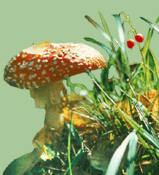European rarities in Estonia: Eagle Owl, master of nights
Rein Nellis takes a glance at the present and future of the European biggest owls the Eagle Owl. In Estonia, the Eagle Owl mostly inhabits the coastal regions. Currently there are about 120-200 pairs of Eagle Owls living in Estonia. The cover story presents the biology and life style of the owl, and is supplied with expressive photographs about the majestic bird. And although there is no evidence of the decline of the population in Estonia, the Estonian Ornithological Society keeps an eye on Eagle Owls and looks forward to any reports about the species.
Aspens of the world
Ülo Tamm introduces the relatives of the tree of the year aspen tree. There are 5 species of aspen trees in world: 2 in North America and 3 in Europe and Asia; in addition there are a number of subspecies and hybrids.
Estonian Nature enquires
Urve Kallavus explains the reasons for the spread of mould in buildings.
Karin Poola writes about the perspectives of founding an environmental education and information center on the island of Hiiumaa.
How to assess the method of radiocarbon dating in current conditions?
Jaan-Mati Punning describes the essence and main challenges of the 40-years old method of radiocarbon dating. The main conclusion made 40 years ago should be kept in mind today as well: the method of radiocarbon dating should only be used as a valuable supplementary tool to other methods. Some examples of problems accompanying the calibration of dating are presented on figures.
Muraste Nature Protection Area
Roland Müür introduces a recently founded protected area near Tallinn. The main values of the area are a section of the Baltic Klint and several rare forest habitats. The Muraste Nature Protection Area also has a hiking trail.
Essay by Tiit Kändler: how standards set by man can distress the man himself.
European rarities in Estonia: Dunlin
Andres Kuresoo presents a modest bird rarity, the Dunlin, which inhabits mostly the coastal areas, but also inland wetlands. In case of the worst scenario, the Dunlin population around the Baltic Sea will perish as quickly as in 20-30 years. The main reason for the loss of the population is the overgrowth of coastal meadows.
Interview: why are insects of the size they are?
Toomas Kukk has interviewed Toomas Tammaru, a researcher of animal ecology
Practical tips: how to find meteorites?
Reet Tiirmaa gives advice on how to recognize the rare stones that come from the sky. The colourful photos of different types of meteorites will help every trearure-hunter on the field. The Institute of Geology of the Tallinn Technical University waits for new discovered meteorites.
In search for the legendary Jüssi lakes
Urmas Abel and his friends took a 2-day hike at beautiful Kõrvemaa, a land of bogs and forests in North Estonia. This uninhabited area full of lovely lakes is perfect for hiking, and the numerous breath-taking views are worth every challenge one can meet on the way.
Changes in the list of protected vascular plant species in 19362004
Elle Roosaluste takes a peek into the history of protected plant species in Estonia. She points out important dates when relevant changes were made to the list. The article is complemented with the lists of protected plant species of both 1936 and 2004.
| 

![[IN ENGLISH]](images/gb.gif)





